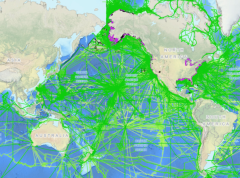Projects
Below are just a few examples of some of the crowdsourced bathymetry projects being carried out around the world.
The Great Barrier Reef Project
In 2018, the ‘Crowdsourced bathymetry on the Great Barrier Reef’ project began to collect bathymetry and navigation data from volunteer vessels using their own echo sounder and GPS sensors. The Project uses TeamSurv-supplied SmartLog USB data loggers installed onto volunteer vessels to collect singlebeam depth data throughout the Great Barrier Reef in north-eastern Australia. Funding for the loggers and installation costs were provided by the Great Barrier Reef Foundation. A wide variety of vessels from dive expedition boats, luxury motor yachts, commercial fishing and government vessels, now generate data coverage to remote parts of the Great Barrier Reef previously lacking digital bathymetry data. These new data are being used to improve a high-resolution 3D depth model for the Great Barrier Reef that is widely used by the general public, marine managers and scientists.
The Nippon Foundation-GEBCO Seabed 2030 Project
Seabed 2030 is a collaborative project between The Nippon Foundation in Japan and the General Bathymetric Chart of the Oceans (GEBCO) with a mission of inspiring 100% mapping of the ocean floor and making it freely available to all by 2030. In addition to producing and delivering global GEBCO products, Seabed 2030 also works alongside the IHO’s Crowdsourced Bathymetry (CSB) Initiative and is equipped to supply data logging equipment or software, provide technical support to vessels, download data from data loggers or remotely log data from shore sites, aggregate collected data and facilitate the data transfer – all we need you to do is volunteer to get involved! Visit seabed2030.org to learn more about The Nippon Foundation-GEBCO Seabed 2030 project and see this video for further information on mapping the oceans through citizen science.
The International SeaKeepers Society
The International SeaKeepers Society promotes oceanographic research, conservation, and education through direct involvement with the yachting community. Privately-owned vessels can participate in increasing our knowledge of the ocean by sharing depth measurements from navigation instruments while out at sea. Yachts explore the world’s oceans, often in areas where data is sparse, non-existent or of poor quality. These are exactly the places where contribution of global seafloor mapping efforts can have the greatest impact. Learn more about the Discovery Yacht Program!
Great Lakes Observing System
The Great Lakes comprise 21% of the world's surface fresh water, which has not been mapped in high resolution. The Great Lakes Observing System (GLOS) is bringing CSB to the Great Lakes via a near real-time cloud based data pipeline. GLOS is capturing data from vessels of opportunity to increase density of depth measurements from the vessel's onboard, organic single beam echo sounders. The goal is to assist in creating a detailed bathymetric surface ("The Great Map"), available to the public, in support of the Lakebed 2030 initiative.
Working with partners in the academic, government and private sector, data are semi-automatically collected and transmitted to the cloud for processing, surface generation and submission to the IHO CSB Bathymetry Initiative. These efforts will aid in a greater understanding of the marine environment in the Great Lakes leading to more informed decision-making.
Crowd the Bay Program
The Center for Ocean Mapping and Innovative Technologies (COMIT) at the USF College of Marine Science in St. Petersburg, Florida is building a new pilot program, called Crowd the Bay, to expand CSB efforts in and around Tampa Bay, Florida.




Share this page: